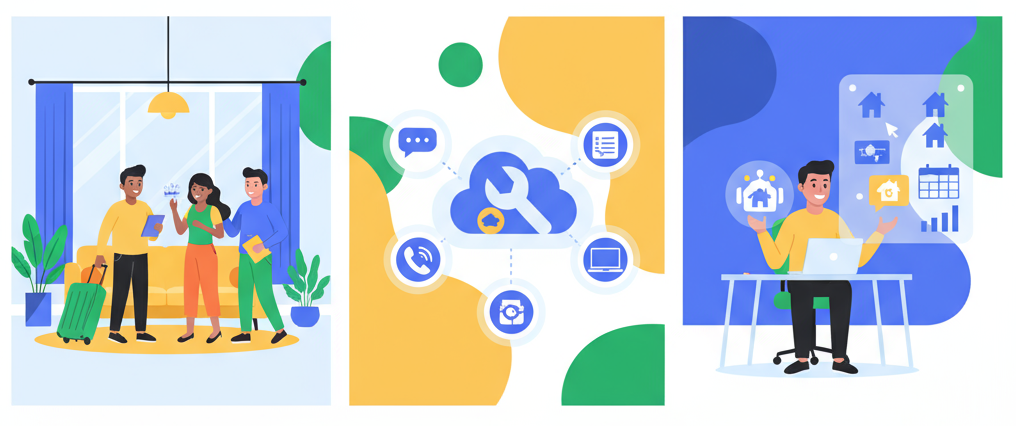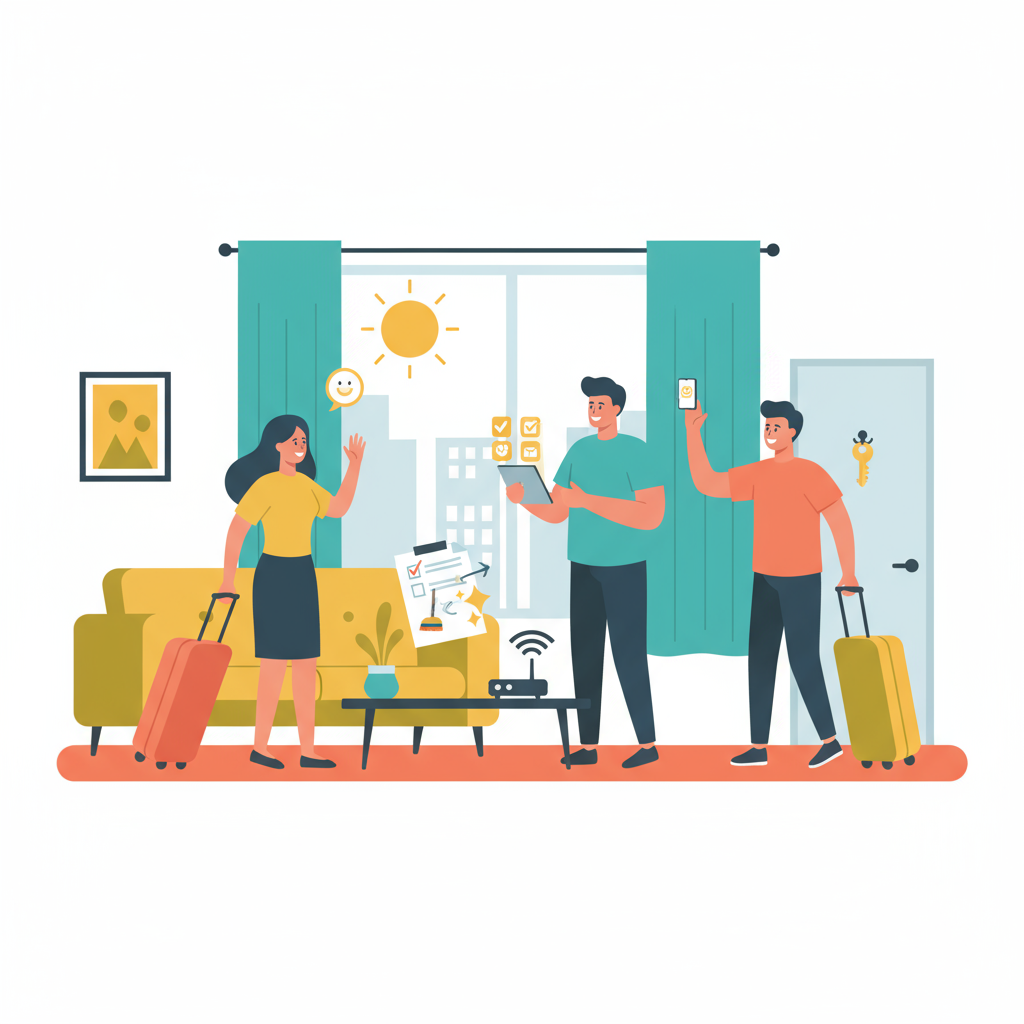Key Takeaways
Listing square footage builds trust and sets accurate guest expectations before booking.
Clear size details help guests compare properties and reduce negative reviews about “smaller than expected” spaces.
Accurate measurements make your listings more competitive, especially for long stays or group bookings.
Ever had a guest mention that your “spacious apartment” felt smaller than expected? You’re not alone. Size perception is one of the most common reasons behind disappointed guests, mismatched reviews, and refund requests. In a competitive market, even small gaps between expectation and reality can turn a five-star stay into a complaint.
Today’s guests want clarity. They’re comparing dozens of listings before booking, and square footage is one of the simplest ways to set expectations early. When guests know exactly how much space they’ll have, they arrive confident — not cautious.
For scaling operators, accuracy matters even more. Managing multiple listings, investor expectations, and occupancy targets leaves little room for confusion. Inconsistent or missing size details lead to frustration, cancellations, and lost trust. Transparent square footage not only prevents awkward “it looked bigger in photos” moments — it also makes your listings easier to compare and more appealing to families, groups, and remote workers who value space.
In this guide, we’ll unpack why listing square footage matters on Airbnb, how it influences guest satisfaction, and the simple, reliable ways to measure and present your property’s size for maximum impact.
Why Square Footage Matters in Airbnb Listings
In a space where visuals and first impressions drive booking decisions, sharing your property’s square footage helps guests trust what they see, compare options confidently, and walk in with the right expectations.
Builds guest trust and transparency
Guests want specifics before they book, especially families, groups, or business travellers planning longer stays. Listing clear property dimensions removes uncertainty and shows that you value honesty from the start.
When you include square footage, guests can assess whether your property truly meets their needs, rather than relying on how wide a camera lens makes a room look.
Helps guests compare listings easily
When travellers browse Airbnb, they often have a dozen tabs open at once. Size details help your property stand out and make it easier for guests to compare options side by side.
Sharing your Airbnb square footage allows them to quickly see if your listing fits their purpose, whether that’s space for a remote office, a family gathering, or simply a more comfortable layout.
Reduces post-stay complaints
Few things harm reviews faster than guests feeling misled about space. Adding square footage to your listing sets expectations early, so guests know exactly what they’re booking.
This simple detail helps prevent “smaller than expected” comments and creates a smoother experience for everyone involved. With fewer surprises, you’re more likely to receive genuine, positive feedback that strengthens your reputation and ranking.
Save yourself from your inbox
Automate with Uplisting
Automated guest messages keep your guest informed from booking through to check-out. They’re designed to answer questions before they arise, saving you time whilst keeping your guests happy.
When You Should Include Square Footage
City apartments, compact urban units, and properties with quirky layouts all benefit from clear square footage details.
Photos alone rarely capture scale in a split-level studio or a loft with odd angles. Add the exact measurement to help guests picture the space before booking. Luxury rentals, high-end listings, and longer-term stays also call for square footage—guests weigh every square foot against the nightly rate, location, and amenities.
Families, remote workers, and groups searching for more than just a place to sleep want to know if there’s room for work, play, or actual living. For single rooms or classic shared spaces, square footage can easily confuse. Guests considering a private bedroom inside a shared home usually care more about access, privacy, and which common areas they get to use.
In short, square footage should show up when it sharpens the picture for the guest. Leave it out when numbers add clutter instead of clarity.
How to Calculate Your Property’s Square Footage
Getting a precise number for Airbnb square footage doesn’t have to be complicated!
Start with a tape measure and a notepad. For each finished room, measure the length and width in feet or meters. Multiply the two numbers for each space, then add everything together for your total area. Include bedrooms, bathrooms, kitchens, hallways, closets, and laundry rooms, as long as the space is finished and usable.
Skip garages, unfinished basements, open attics, and balconies unless they’re fully enclosed and climate-controlled. For outdoor extras like rooftop decks or terraces, keep their measurements separate and spell them out, writing “plus 200 sq ft private terrace” removes any confusion and helps guests know exactly what’s included.
Looking for shortcuts? Measurement apps on your phone, digital floor plan tools, and laser distance meters all help speed up the process and reduce mistakes.
Pick one measurement unit, either square feet or square meters, and stick with it across your listings. Clearly noting the unit in your description keeps things consistent and makes guest comparisons easier, especially when someone filters listings by Airbnb square footage.

All-in-one Vacation Rental Software and Channel Management System
Get started in seconds by connecting Airbnb
Manage short-term rentals & bookings, message guests, take payment, and so much more. All in one easy-to-use platform (that never double-books).
How to Present Square Footage in Your Listing
Once you’ve measured your space accurately, the next step is showing it clearly. How you present your property’s size can make all the difference between a listing that builds trust and one that leaves guests guessing.
The goal here is to highlight square footage naturally, support it with visuals, and keep details consistent everywhere your property appears.
Integrate it naturally
Guests scan headlines and summaries first, so mention square footage where it counts.
A title like “Modern 850 sq ft apartment near city centre” sets expectations immediately and draws attention in search results. Repeating the figure in your description (especially when explaining layout or sleeping arrangements) helps guests quickly see if your property fits their needs.
Including Airbnb square footage in both the headline and body text removes doubt and helps guests picture the space before they book.
Pair it with floor plans or visuals
Numbers tell one part of the story, while visuals fill in the rest.
A clear floor plan or simple layout diagram gives guests a real sense of scale. It doesn’t need to be complex; even a basic sketch helps show room relationships and flow. Combine this with bright, well-framed photos that match what’s described.
When size details align with imagery, guests know exactly what to expect, reducing surprises and boosting satisfaction.
Stay consistent across platforms
Guests often cross-check listings on multiple sites before booking. If your Airbnb square footage doesn’t match what’s listed on Booking.com or your direct site, trust takes a hit. Use the same figure everywhere and update it any time your property changes.
Consistency reassures guests and simplifies management, especially as your portfolio grows and stakeholders track performance across channels.
Common Mistakes to Avoid
Plenty of operators get tripped up by a few classic errors when listing Airbnb square footage. Inflating numbers (calling a 925 square foot apartment “1,000 sq ft”) might look tempting, but guests spot the difference as soon as they check in. Disappointment follows, and review scores often take a hit as guests call out the mismatch.
Switching between square feet and square metres without giving a clear conversion only adds to the confusion.
A guest from Europe scanning your listing for a family trip has no idea whether 800 square feet means a cozy studio or enough room for a group dinner. Always pick one unit and use it for every property. If your portfolio spans different countries, offer both numbers in the description (“800 sq ft (74 sq m)”) to make comparison simple and cut down on questions from international guests.
Skipping updates after a renovation or layout change causes headaches down the line. Expanding into the next unit, removing walls, or adding a new finished basement all change the actual space. If you leave old numbers in place, guests feel misled and your listing loses credibility fast.
Update every channel and site where the property appears, every single time you alter usable space. Clear, current numbers show guests (and stakeholders) you keep your details sharp and your operation tight.
Create 5-star guest experiences
Give your guests unforgettable experiences
With Uplisting, you can send the right messages at the right time on all booking sites. Read and respond to guest messages in a single, unified inbox — whether you’re at the office or on the go.
Simplifying Listing Accuracy with Uplisting
Clear square footage is a smart way to set expectations, reduce complaints, and build trust with guests before they book.
When you include accurate size details in every listing, you help travelers make informed decisions and eliminate unnecessary surprises at check-in. Transparency around square footage supports better guest experiences and stronger review scores across your portfolio.
Whether you're managing five listings or fifty, consistency across channels matters. With the right tools in place, it's easy to keep size details updated and aligned everywhere your properties appear.
Sign up for Uplisting today to take the guesswork out of listing accuracy, guest communication, and operational efficiency.
FAQs About Airbnb Square Footage
Should I list Airbnb square footage in both feet and metres?
Many international guests rely on metric measurements, so adding both units helps travelers compare properties with less friction. Local guests often expect square feet, but including both units clears up any guesswork and cuts down on guest messages asking for conversions.
Does Airbnb require hosts to include size information?
Airbnb doesn’t force hosts to add square footage, but putting the numbers front and center makes your property easier to find in filtered searches and builds confidence before booking. Size details lead to fewer questions and cut down on negative surprises after check-in.
What if my floor plan is irregular or open concept?
Odd shapes and open layouts can be tricky, but breaking the total area into rectangles and adding the measurements gives you a reliable figure. If your space has a flow that’s hard to explain in words, upload a simple diagram or floor plan. Guests get a better feel for the setup and know exactly what to expect.
Can I include outdoor space in my square footage?
Indoor and outdoor spaces play different roles in guest comfort, so keep measurements separate. Spell out interior square footage first, then add a clear note for any deck, patio, or terrace area, like “1,000 sq ft interior plus 200 sq ft rooftop deck.” Guests appreciate knowing what’s inside and what’s bonus space, making your listing stand out for all the right reasons.

















.png)

